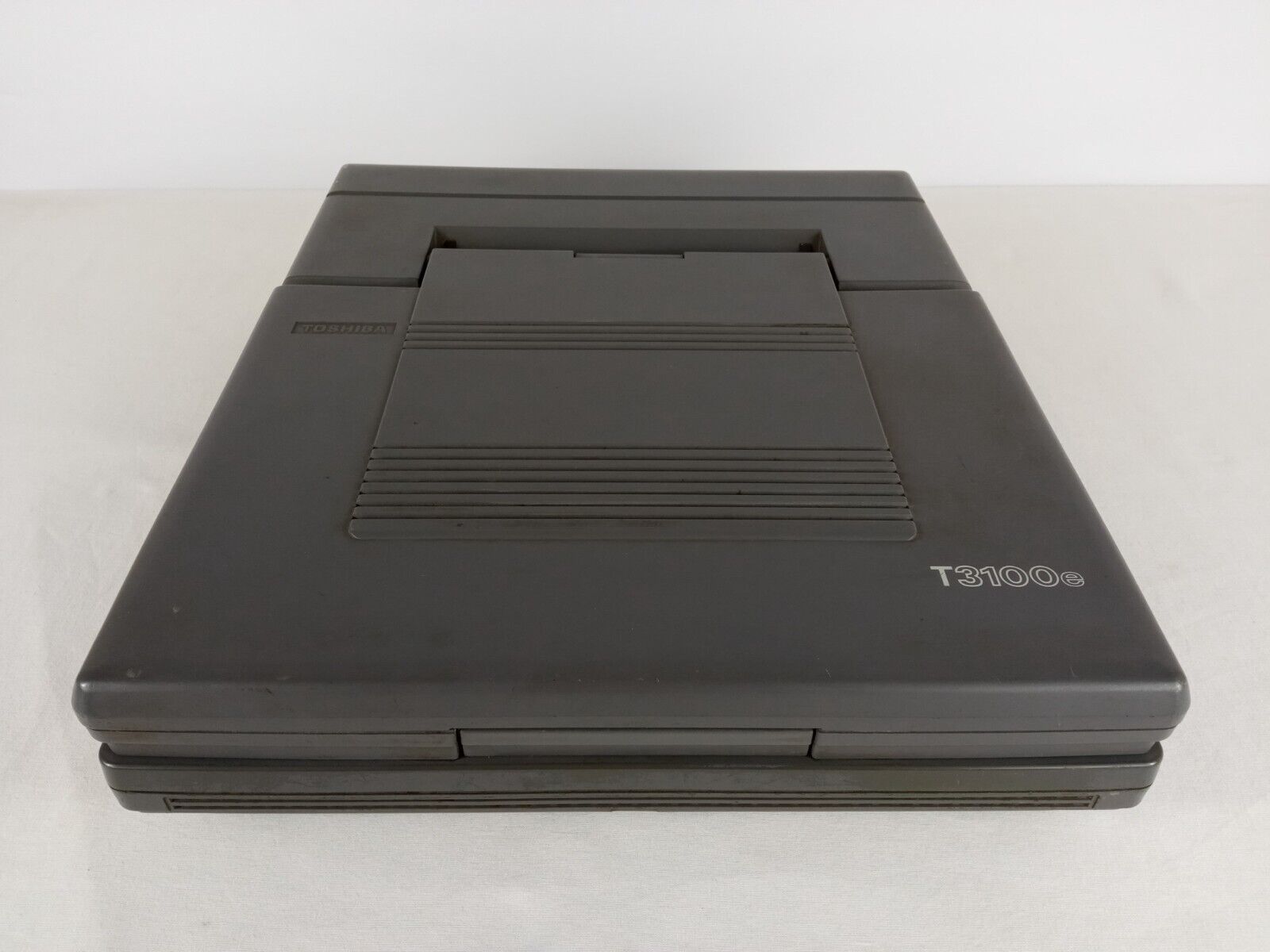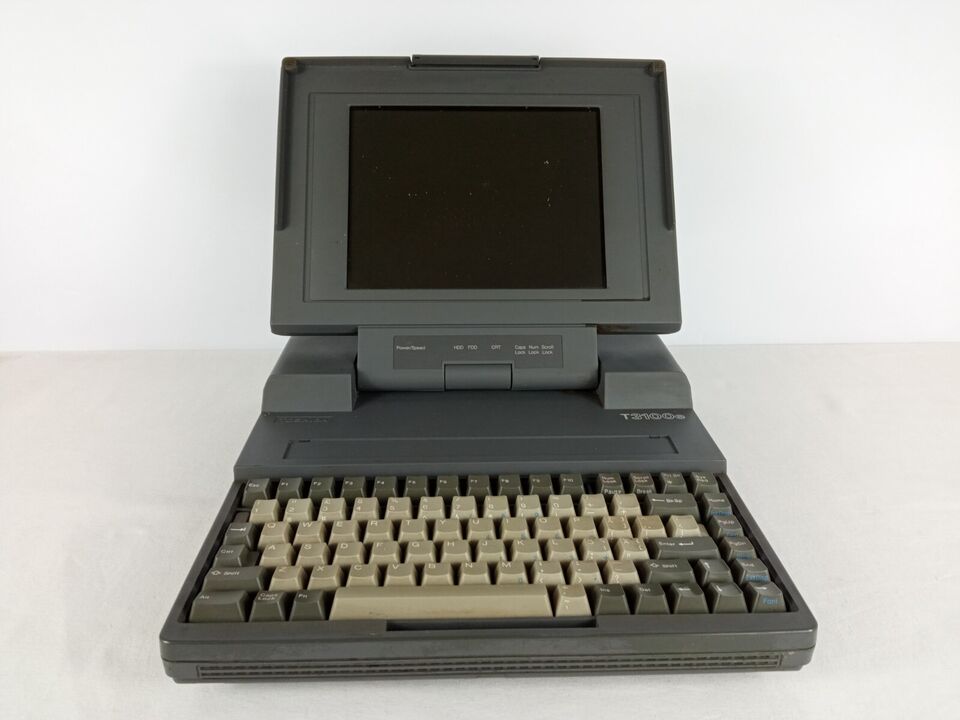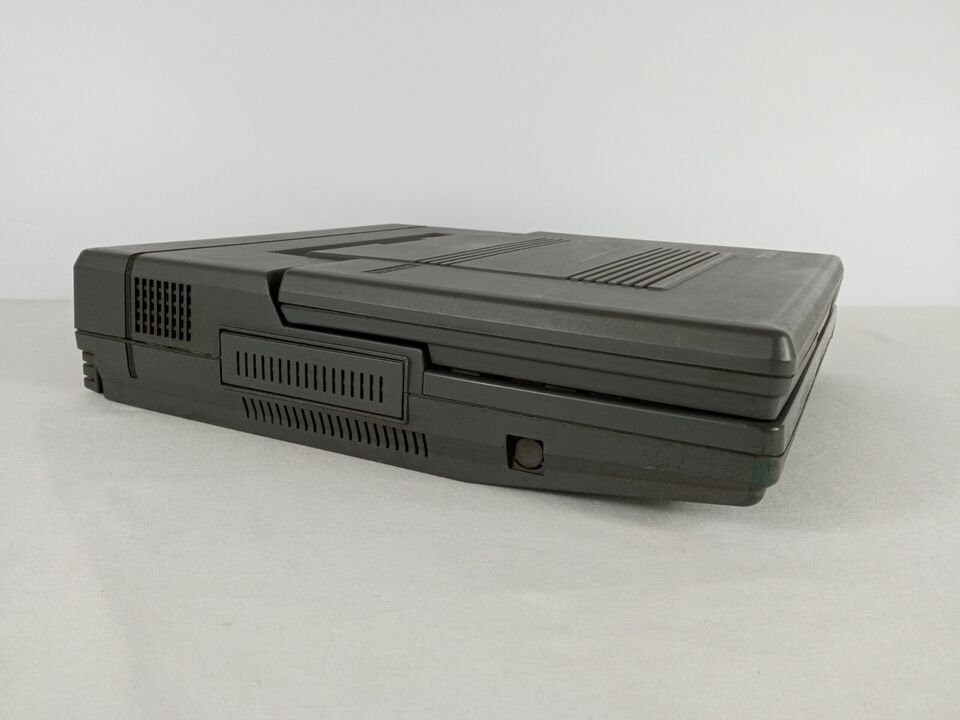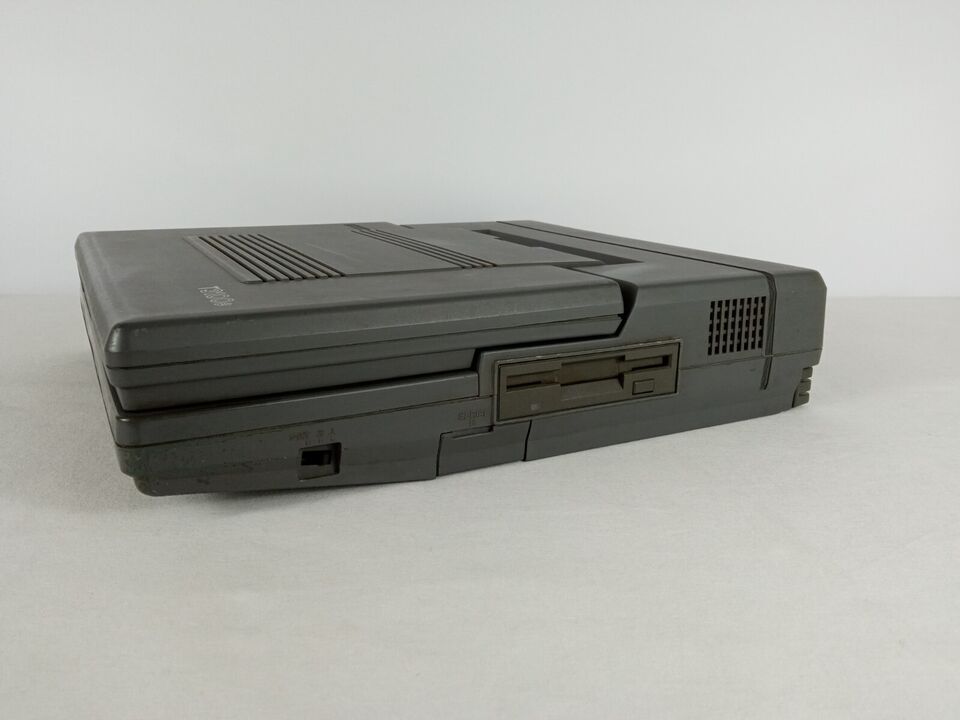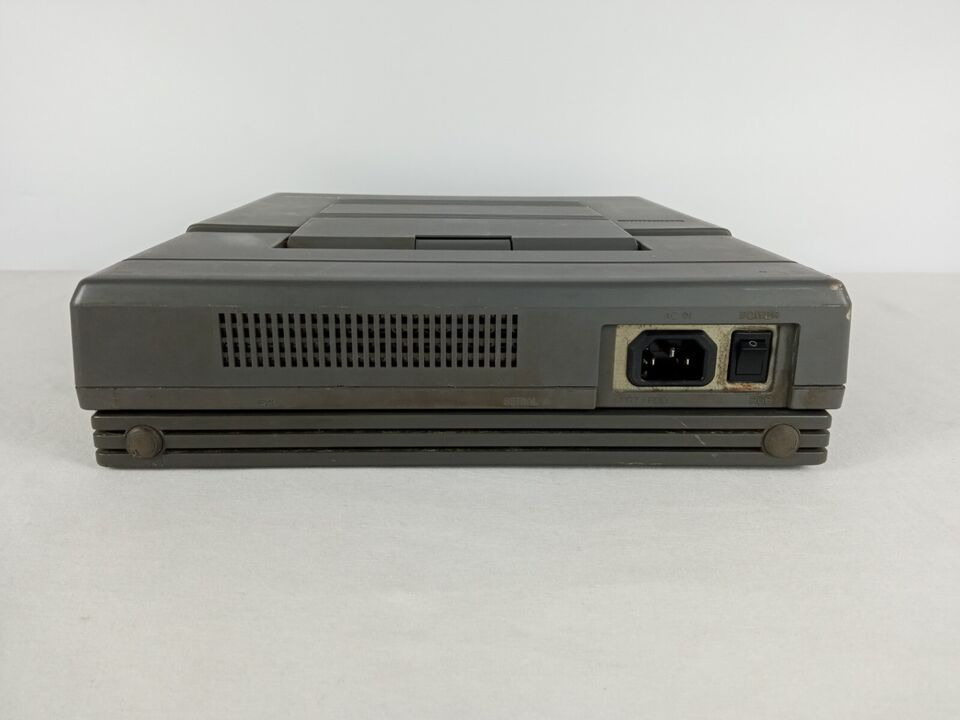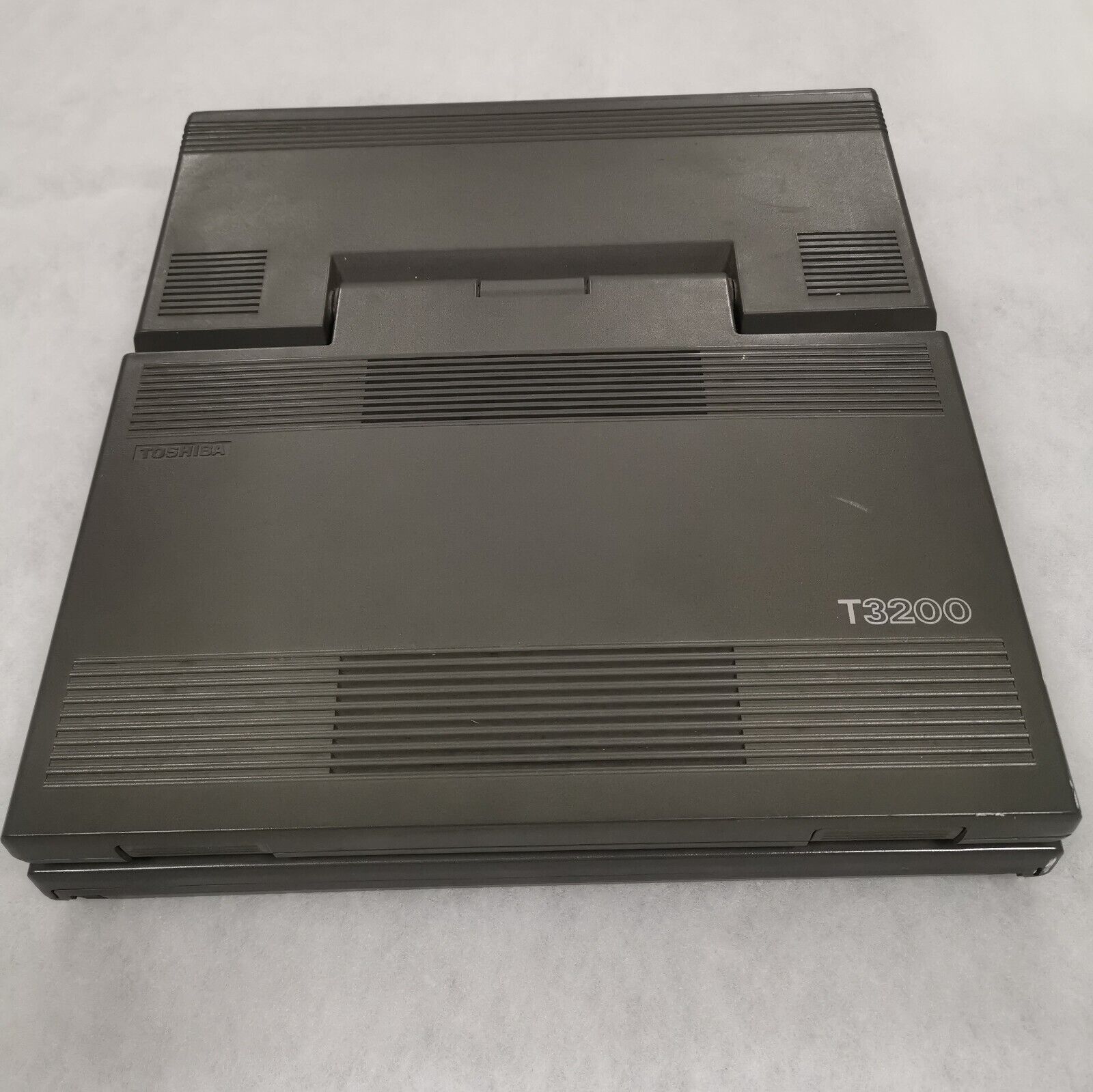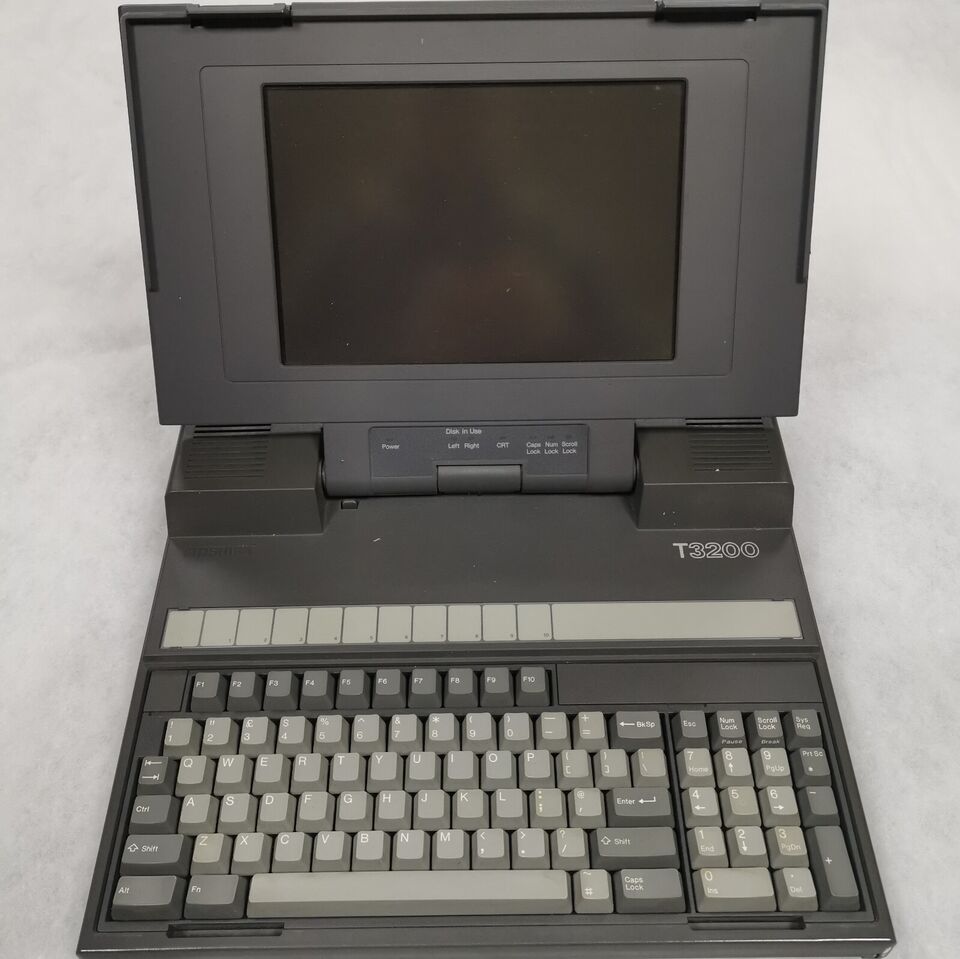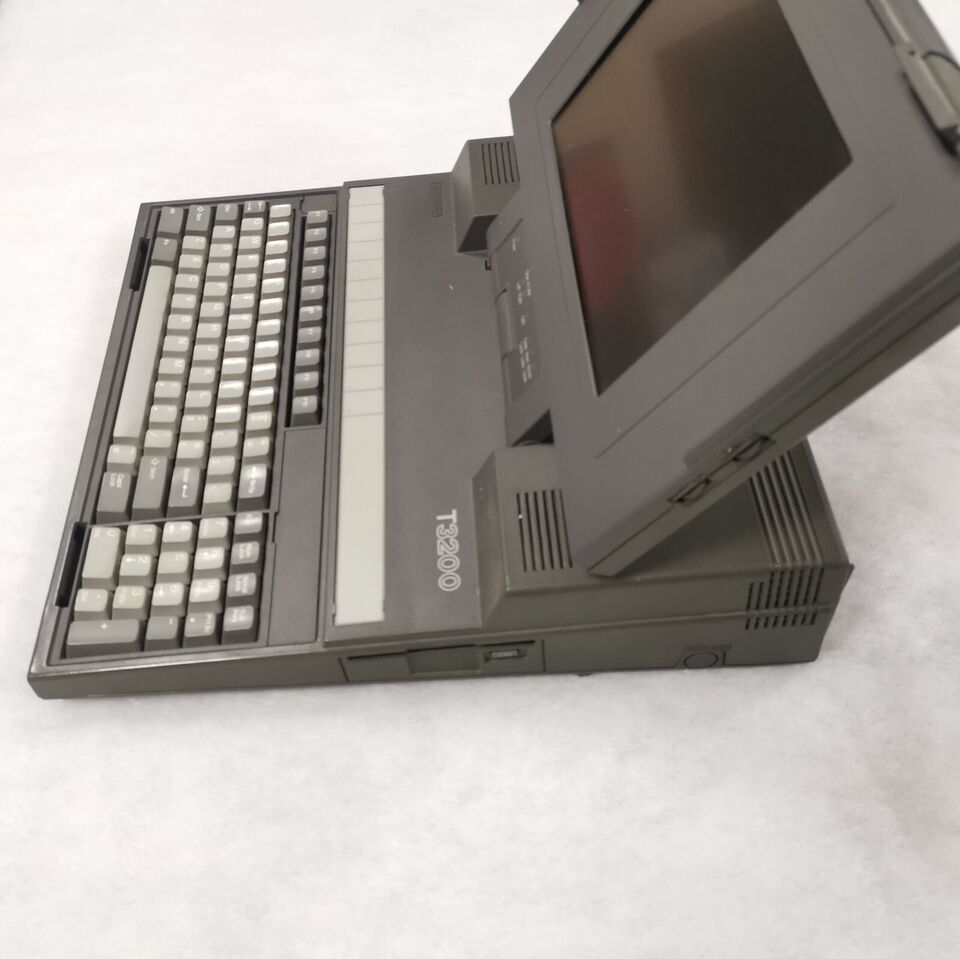 A Brief History of Toshiba Corporation / Dynabook - Part 1
A Brief History of Toshiba Corporation / Dynabook - Part 1
Toshiba laptops were, and still are, a brand name recognised across the globe. What is less well-known is that many of these used the "Dynabook" branding, as this was the company behind the development of their laptops from 1985 with the T1100 up to today.
This article will take you down memory lane with the Toshiba range of laptop computers during the DOS era, with this first part looking at their early years from 1985 to 1990. In total we'll be looking at the following laptops across several parts to this article:
| 1985 T1100 (8088 4.77 MHz, 256 KB RAM, CGA mono LCD) 1986 T1100 Plus (8086 7.16 MHz, 256 or 640 KB RAM, CGA Mono LCD) T3100 (80286 8 MHz, 640 KB of RAM, 10 MB hard disk, gas plasma display) 1987 T3100/20 (as T3100 but with 20 MB hard disk) T1200HD? T3200 (80286 12 MHz, 1 MB of RAM, 40 MB hard disk) 1988 T3100/e (80286 12 MHz or 16 MHz, 1 MB RAM, 20 MB hard disk) 1989 T3100e/40 (as T3100/e but with 40 MB hard disk) T3200SX (386SX-16, 1 MB RAM, 40 or 80 MB hard disk, 640x480 VGA mono) 1990 T3100SX (386SX-16, 1 MB RAM, 40 or 80 MB hard disk, VGA gas plasma display) T3200SXC (386SX-20, 1 MB RAM, 40 or 80 MB hard disk, 640x480 colour VGA STN) 1991 T2000SX (386SX-16, 1 MB RAM, 40 MB hard disk, 8.5" mono STN) T5200 (386SX-20, 2 MB RAM, 40 MB hard disk, mono gas plasma) T5200-100 (as T5200 but with 100 MB hard disk) T5200-200 (as T5200 but with 200 MB hard disk) T5200C (386SX-20, 4 MB RAM, 200 MB, active-matrix colour) 1992 T2200SX (386SX-20, 2 MB RAM, 60 MB, 9.5" mono STN display) T3300SL (386SL-20, 2 MB RAM, 80 MB, mono STN display) T4400SX (486SX-25, 4 MB RAM, 80 MB, 9" mono gas plasma) T4400SXC (as T4400SX but with 9" mono STN display) T4400C (486SX-25, 4 MB RAM, 213 MB, 9.5" colour TFT display) T6400SX (486SX-25, 4 MB RAM, 120 MB, mono gas plasma) T6400SXC (as T6400SX but with active matrix colour display) T6400 (486DX-33, 4 MB RAM, 200 MB, 10.4" mono gas plasma) T6400DXC (as T6400 but with 10.4" colour TFT display) |
1993 T4500 (486SX-20, 4 MB RAM, 86 MB hard disk, 9.5" mono STN display) T4500C (as T4500 but with colour STN display) Satellite T1850C (386SX-25, 4 MB RAM, 80 MB, 9.5" colour STN display) Satellite T1900 (486SX-20, 4 MB RAM, 80 MB, 9.5" mono STN display) Satellite T1900C (as T1900 but with 9.5" colour DSTN display) Satellite T1900C-120 (as Satellite T1900C but with 120 MB hard disk) Satellite T1900C-200 (as Satellite T1900C but with 200 MB hard disk) 1994 Satellite T1910 (486SX-33, 4 MB, 130 MB, 9.5" mono STN VGA) Satellite T1910CS (486SX-33, 4 MB, 130 MB, 9.5" colour DSTN VGA) Satellite T1960CS (486DX2/50, 4 MB, 200 MB, 9.5" colour DSTN VGA) Satellite T1960CT (486DX2/50, 4 MB, 200 MB, 8.4" colour TFT VGA) Satellite T2400CS (486DX2/50, 8 MB, 250 MB, 9.5" colour DSTN VGA) Satellite T2400CT (486DX2/50, 8 MB, 250 MB, 8.4" colour TFT VGA) Portege T3400CT (486SX2/33, 4 MB, 250 MB, 7.8" colour TFT VGA) Portege T3600CT (486DX2/50, 8 MB, 250 MB, 8.4" colour TFT VGA) T4700CS (486DX2/50, 8 MB, 213 MB, 9.5" colour DSTN display) T4700CT (486DX2/50, 8 MB, 213 MB, 9.5" colour TFT VGA) T4800CT (486DX4/75, 8 MB, 524 MB, 9.5" colour TFT VGA) 1995 Satellite T2100 (486DX2/50, 4 MB RAM, 250 MB, 9.5" mono DSTN VGA) Satellite T2100CS (486DX2/50, 8 MB EDO, 335 MB, 10.4" colour DSTN VGA) Satellite T2100CT (as T2100CS but with 8.4" active matrix display) T2110CS (486DX4/75, 4 MB RAM, 320 MB, 10.4" colour DSTN VGA) T2130CS (486DX4/75, 8 MB RAM, 500 MB, 10.4" colour active matrix VGA) T2130CT (486DX4/75, 8 MB RAM, 500 MB, 10.4" colour DSTN VGA) T2400CS (486DX2/50, 4 MB RAM, 320 MB, 9.5" colour DSTN VGA) Satellite Pro T2150CDS (486DX4/75, 4 MB, 503 MB, 10.4" colour DSTN VGA) Satellite Pro T2150CDT (486DX4/75, 8 MB, 503 MB, 10.4" colour active matrix VGA) Satellite T4900CT (Pentium-75, 8 MB, 772 MB, 10.4" colour active matrix VGA) 1996 Portege 610CT (Pentium-75, 16 MB, 687 MB, 9.5" colour active matrix VGA) Satellite Pro 400CDT (Pentium-75, 16 MB, 776 MB, 10.4" colour TFT VGA) Satellite Pro 410CDT (Pentium-90, 16 MB, 776 MB, 11.3" colour TFT VGA) Tecra 700CT (Pentium-120, 16 MB SDR, 1.1 GB, 11.3" colour TFT SVGA) 1997 ... |
1985 - 1987
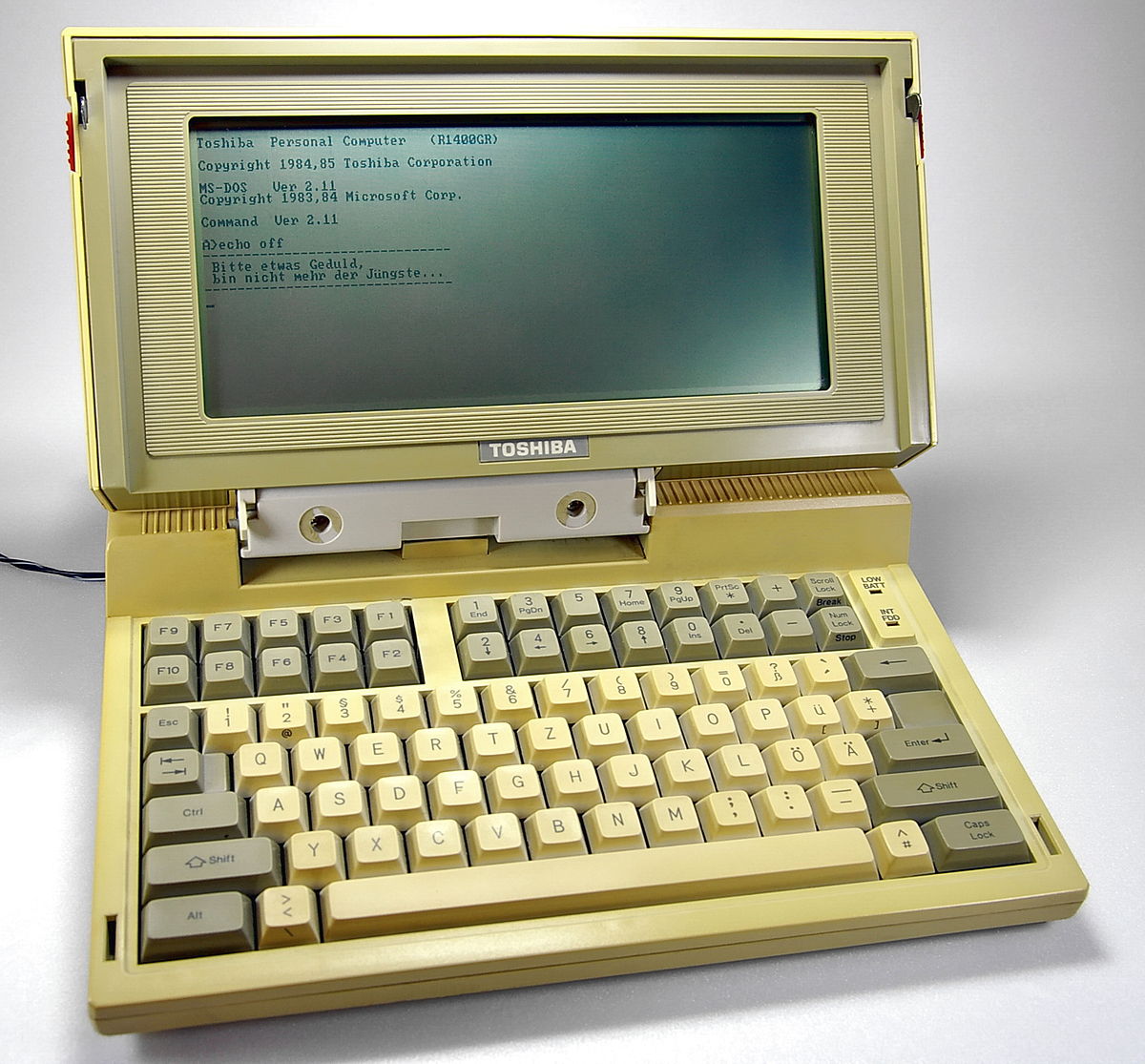 The Toshiba T1100, released in 1985, holds the title as the world's first "laptop" computer. I have a dedicated T1100 page if you wish to know more about this fascinating machine, but in a nutshell the T1100 really delivered the first truly portable computing device to the masses. Measuring just 12.2" wide by 12" deep by 2.6" high, it was a marvel of miniaturisation. Its spec sheet put it firmly alongside the IBM PC Model 5150, though instead of a 5.25" floppy drive it came with an internal 3.5" 720 KB one. At the time, the 3.5" microfloppy was pretty new, with Sony introducing it just 2 years earlier in single-sided form, and having a double-sided double-density one only arriving about a year before this machine. Running an Intel 8088 at 4.77 MHz, a monochrome LCD display that met the CGA graphics standard, and 256 KB of RAM (expandable to 512 KB), it was basic but fully functional.
The Toshiba T1100, released in 1985, holds the title as the world's first "laptop" computer. I have a dedicated T1100 page if you wish to know more about this fascinating machine, but in a nutshell the T1100 really delivered the first truly portable computing device to the masses. Measuring just 12.2" wide by 12" deep by 2.6" high, it was a marvel of miniaturisation. Its spec sheet put it firmly alongside the IBM PC Model 5150, though instead of a 5.25" floppy drive it came with an internal 3.5" 720 KB one. At the time, the 3.5" microfloppy was pretty new, with Sony introducing it just 2 years earlier in single-sided form, and having a double-sided double-density one only arriving about a year before this machine. Running an Intel 8088 at 4.77 MHz, a monochrome LCD display that met the CGA graphics standard, and 256 KB of RAM (expandable to 512 KB), it was basic but fully functional.
On the rear of the unit were all the ports: a 37-pin DSUB port for an second [external] 3.5" floppy disk drive, 25-pin Centronics parallel printer port, and a 9-pin RGB monitor port and RF-style composite out socket. One slider on the rear would switch from the internal floppy drive to external (if fitted), and another slider switched from the internal LCD to external monitor.
The 7-hour battery was built-in with no option to remove it, so you couldn't carry a spare battery to extend your mobile use.
At the time, the latest Microsoft MS-DOS was version 2.01, so this is what it ran. The true test of IBM compatibility was critical for buyers to be persuaded away from IBM's offerings - typically the ability to run Lotus 1-2-3 and Microsoft Flight Simulator was the acid test - something the latter had proved to be a challenge for the manufacturer due to the display, but they did achieve this, along with advertising its use for word processing with WordStar. With its 640 x 200 graphics resolution and 80 x 25 text mode, using standard DOS applications was a breeze, albeit shrunk down on the tiny 9" x 4" LCD.
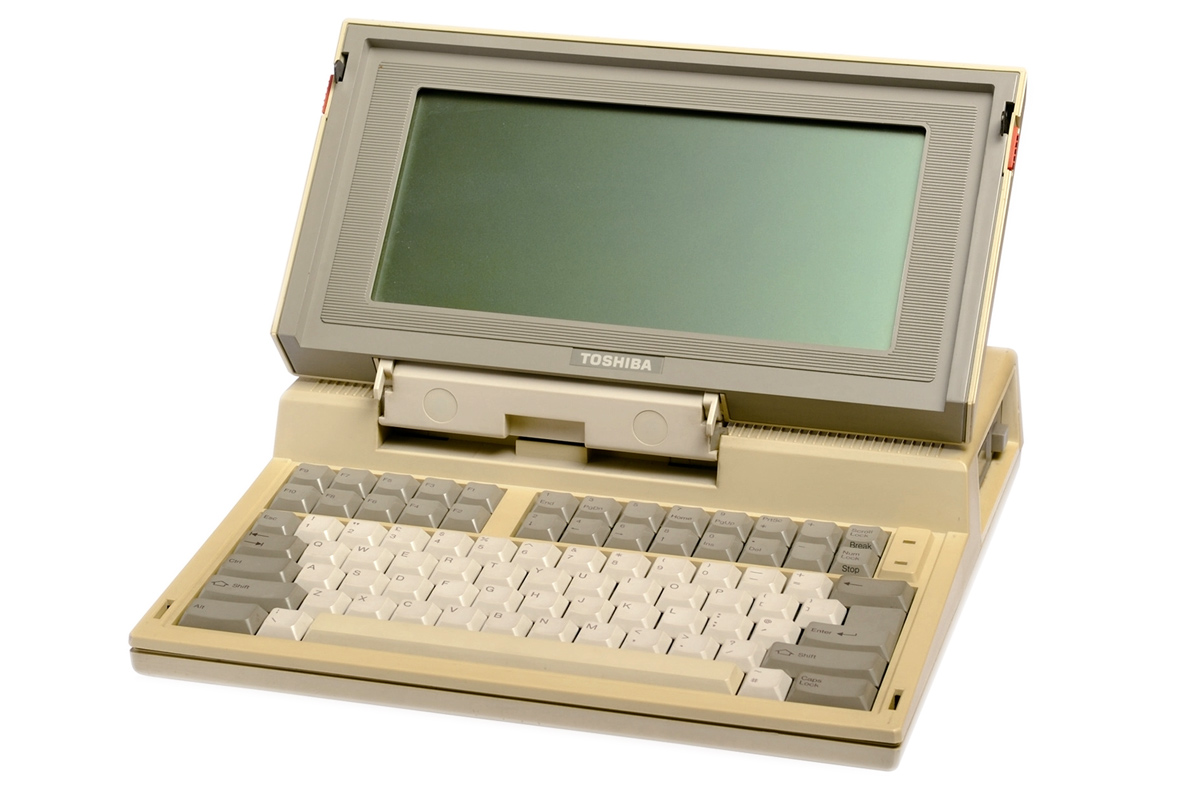 Optional extras were somewhat limited, though a 9-pin serial port / modem accessory could be installed. The Hayes-compatible modem was capable of only 300 baud (bits per second), though later on a 1,200 baud model was released. A switch on the back of the accessory allowed you to switch between serial, modem and off.
Optional extras were somewhat limited, though a 9-pin serial port / modem accessory could be installed. The Hayes-compatible modem was capable of only 300 baud (bits per second), though later on a 1,200 baud model was released. A switch on the back of the accessory allowed you to switch between serial, modem and off.
At the time of its release, the little T1100 came with an MSRP of $1,899, certainly far cheaper than an equivalent IBM Model 5150 at the time.
By mid-1986, buying a T1100 got you the full complement of 512 KB of RAM as standard, and the price tag was just $1,995 - the same price as a base 256 KB model IBM Convertible (512 KB would have cost you $2,385 not including a copy of IBM DOS).
For all of its innovation, there were some shortcomings highlighted by the press. Probably the biggest complaint was the keyboard layout with its two rows of function keys - these read back to front, so F1 was to the top-right and F10 in the lower-left, copying the IBM layout but oriented 90 degrees to the left. The lack of a second floppy drive was also noted (which seems nit-picky today, but back then having two drives was an important factor - in one drive you would keep the program disk, and in the second you would have a disk for your work files), as was the 512 KB of RAM rather than 640 KB. Finally, the slow 300 baud modem was behind the times, as 1200 baud models were prevalent [if expensive].
"The Toshiba T1100 Plus, from Toshiba America, has all the earmarks of a great laptop computer. Its sterling qualities include dual 720K-byte floppy disk drives, 640K RAM, a fast 80C86, a great keyboard, a readable screen that is truly adjustable, and an optional Hayes-compatible 1,200-bit-per-second modem. It runs for up to 8 hours on a charge and weighs in at under 10 pounds. The T1100 Plus can even sit comfortably on your lap without dislocating your knee or leaving an indentation in your stomach.
The design time lavished on the Toshiba T1100 Plus
shows up in the sculpted lines of its plastic shell and its logical keyboard layout. It travels well across town or across the country. Wait no longer if you need a computer that goes where you go: the Toshiba T1100 Plus is it." PC Magazine, January 1987
A year after the launch of the T1100, Toshiba released the T1100 Plus for $2,399 as a direct replacement for the T1100 in their product line-up. Competing directly against the 12.5lb IBM Convertible and Zenith Data Systems Z-181 Portable, the Plus kept the same form factor and design at its forebear, but now offered a version with maximum memory of 640 KB. The Intel 80C88 CPU of the T1100 had been replaced the CMOS-based 80C86 running at a blistering 7.16 MHz, and it came with two 3.5" 720 KB floppy drives. Just as with the T1100 you could opt for an external serial port / 300 baud modem, which also provided the machine with a realtime clock. The screen was also the same, though Toshiba claimed that a new display adapter handled colour-to-greyscale conversions better.
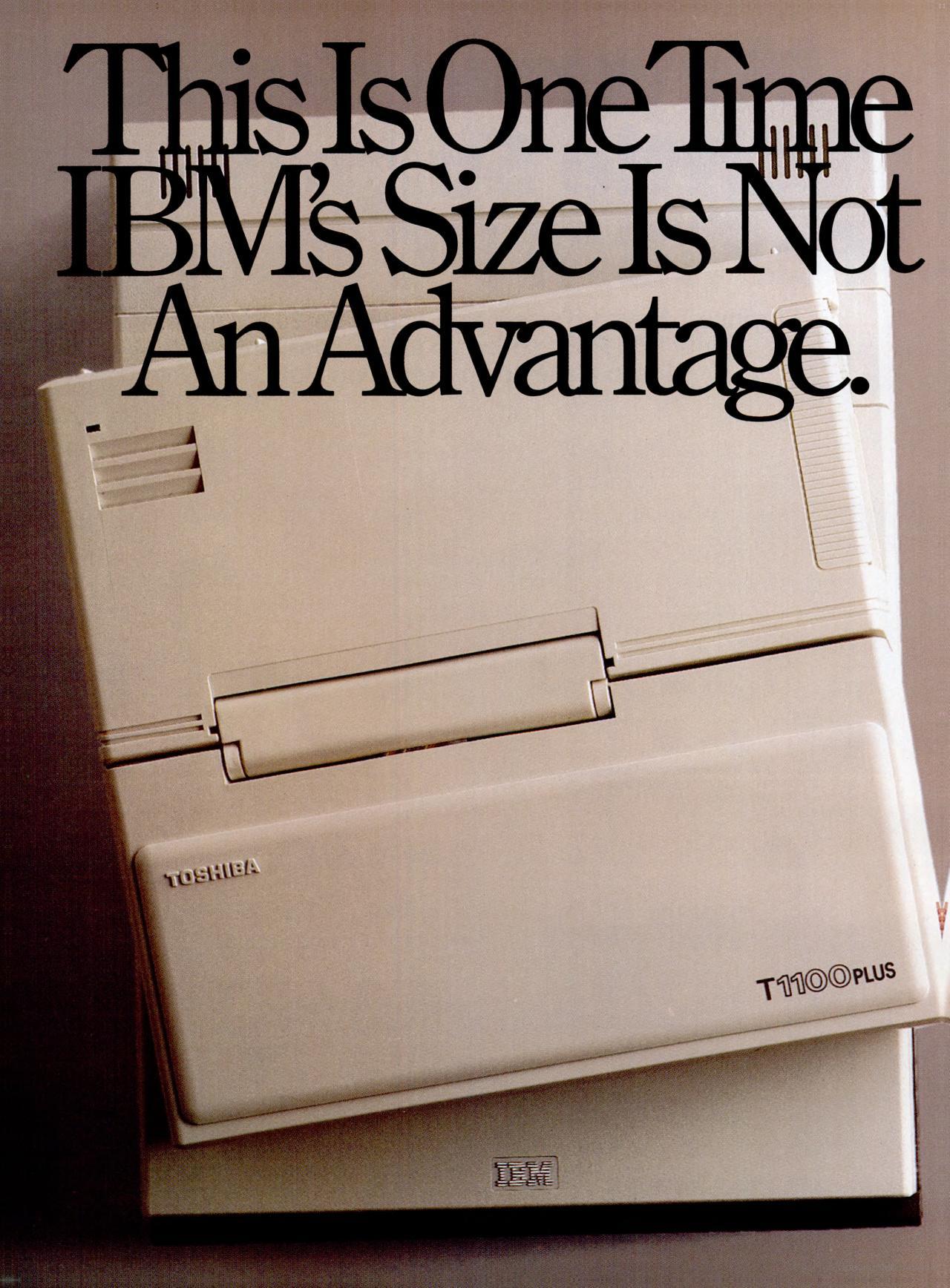
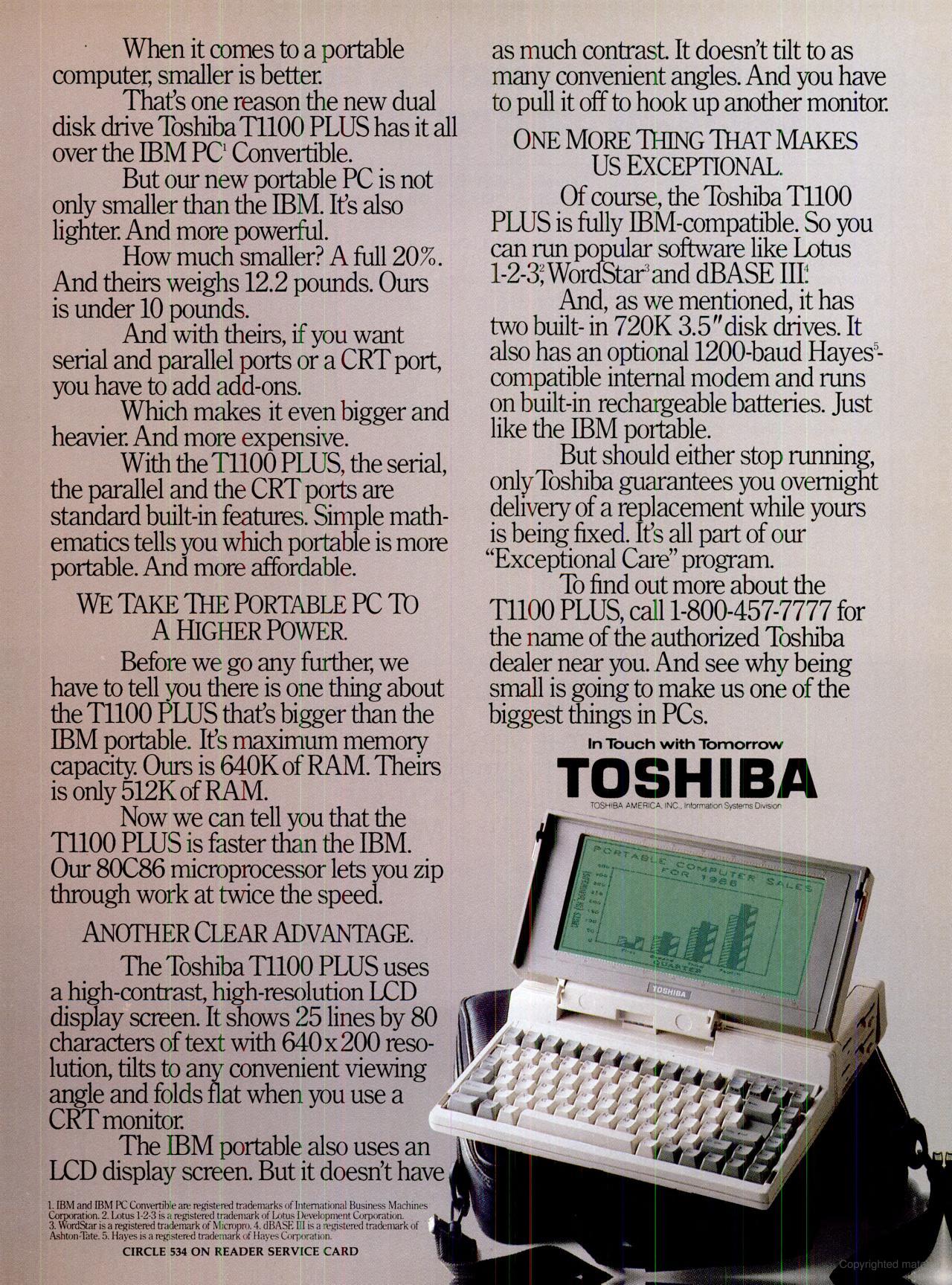 For the T1100 Plus, Toshiba also corrected the funky keyboard layout of the T1100, with the Plus model now having a single row of function keys logically laid out as you would expect.
For the T1100 Plus, Toshiba also corrected the funky keyboard layout of the T1100, with the Plus model now having a single row of function keys logically laid out as you would expect.
The new unit weighed in at a slightly heavier 10lbs - 1lb more than the T1100. At launch, two versions of the T1100 Plus were available: a 256 KB one for $1,995 and a 640 KB one for $2,399.
If you wanted to use a 5.25" floppy disk drive this was a $525 option, though a cheaper option was a board for $99 that allowed connectivity directly to an IBM PC to use the desktop machine's built-in floppy drives as if they were built-into the T1100 Plus.
Compared to the competition, the Zenith Z-181 Portable was almost a direct match specs-wise with the top-of-the-range Plus: 640 KB of RAM, two floppy drives, etc), but was heavier at 11.8lbs. The Zenith did, however, come with an electroluminescent backlit display which had the same aspect ratio as the standard IBM PC. Another benefit of the Zenith was that it came out of the box with the full complement of ports: serial, parallel, RGB external monitor out, composite video out, and a 5.25" floppy drive interface. The Zenith sold for the same price, $2,399.
Also launched in 1986 was the T3100 with a price tag of $4,199 - it was Toshiba's first IBM PC/AT-compatible laptop, and came with an 8 MHz Intel 80286 CPU, 640 KB of RAM, a built-in 3.5" 10 MB MFM hard disk, 3.5" floppy drive, and gas plasma display. MS-DOS 3.2 was bundled in. The T3100 stood out compared to its T1100 siblings with its dark grey case and contrasting light grey keys.
"Look, if you like PCs and you don't go a little weak in the knees when you see Toshiba America's stylish, powerful lap machine, the T3100, see your doctor. You've got tired blood.
The T3100 is an AT
in a 15-pound flat box you can throw into your attache case. Let's get the bad stuff out of the way first; it won't run on batteries and it costs almost 5 G's. If neither of those facts turns you off, it's good news from here on in: an 8 MHz 80286 processor, built-in 10-megabyte hard disk and 720K-byte IBM PC Convertible-compatible micro-floppy, a superb high-resolution gas plasma screen, good to better-than-good keyboard, and a high level of PC compatibility. And an optional ($295) 1,200-bit-per-second internal modem (yes, Virginia, it's Hayes-compatible) that's definitely the most line-noise-resistant one I have ever used.
The T3100's hard disk is the slowest ever crafted by man, but is locks the heads up out of harm's way every few seconds. So slow disk access speed may be a fair trade-off for not having to remember to run a head-park drill every time you want to pick it up and go.
I wish it were about 5 pounds lighter. I wish more graphics programs had screen drivers for its wiry sharp 600 by 400 graphics mode, so it didn't have to (automatically) fall back into its CGA emulation for graphics. And I wish the hard disk was bigger and faster. But as it sits, the T3100 ties with the Compaq Deskpro 386 for the most interesting hardware of the year." PC Magazine, January 1987
 Because of its built-in hard disk and gas plasma display, it tipped the scales at 15lbs, but at the time of its launch the T3100 was the smallest, most full-featured laptop on the market, winning it the PC Magazine Award for Technical Excellence in 1987. The laptop came with all the usual ports on the back: parallel port, serial port, and RGB external monitor out, and it came with a realtime clock built-in. Unlike the T1100 range it could only run on mains power, so was more of a pseudo-portable PC.
Because of its built-in hard disk and gas plasma display, it tipped the scales at 15lbs, but at the time of its launch the T3100 was the smallest, most full-featured laptop on the market, winning it the PC Magazine Award for Technical Excellence in 1987. The laptop came with all the usual ports on the back: parallel port, serial port, and RGB external monitor out, and it came with a realtime clock built-in. Unlike the T1100 range it could only run on mains power, so was more of a pseudo-portable PC.
The 8" x 6" gas plasma display (9.5" diagonal) was bright and beautiful, supporting a graphics resolution of 640 x 400 using a special mode similar to the Olivetti M24/AT&T 6300, and backward-compatibility to IBM's CGA standard at 640 x 200. The memory could be expanded to a maximum of 5 MB on the motherboard with the use of one of two memory kits available from Toshiba: a 512 KB kit and a 2 MB kit. Any memory above the 640 KB conventional limit was LIM/EMS-compliant or you configure it simply as XMS (Extended Memory Specification).
An optional internal 300/1200-baud modem would set you back $395, though aftermarket internal modems were also produced that would fit inside a T1100 Plus or T3100 for $339.
Aside from the modem, other optional extras for the T3100 included an external 5.25" 360 KB floppy drive for $499, a "PC Floppy Link" which allowed you to connect the laptop to an IBM PC and use its built-in floppy drives as if they were its own ($199), expansion chassis and cable with five 8-bit ISA slots ($999), expansion interface card ($199), and an external numeric keypad ($99).
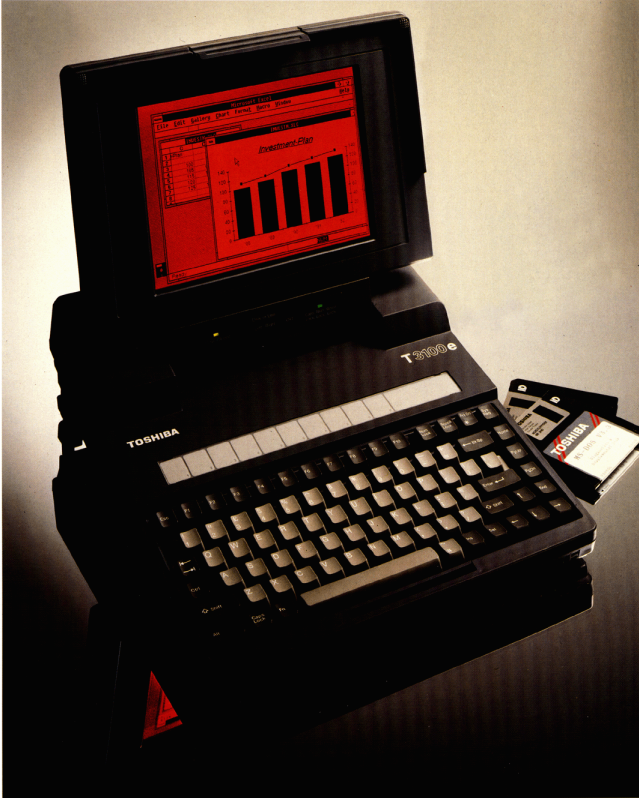 A number of model variants of the T3100 were released between 1986 and 1990.
A number of model variants of the T3100 were released between 1986 and 1990.
- T3100 - 80286 8 MHz, 640 KB RAM (expandable to 2 MB), JVC JD-3812M 10 MB hard disk, 3.5" 1.44 MB floppy drive. Bundled with Toshiba MS-DOS 3.2. Released ~July 1986.
- T3100/20 - as T3100 but with a 20 MB JVC JD-3824R00-1 or JVC JD-3824ROTO 3.5" RLL hard disk. Bundled with Toshiba MS-DOS 3.2, Lotus Symphony and Lotus Metro. Released ~December 1987.
- T3100e - 80286 12 MHz or 16 MHz, 1 MB RAM (expandable to 5 MB), 20 MB hard disk, 2 serial ports. Bundled with Toshiba MS-DOS 4.01 (3.2, 3.3 or MS-OS/2 1.1 optional). Released ~October 1988.
- T3100e/40 - as T3100e but with a 40 MB hard disk. Released ~October 1989.
- T3100SX - 80386SX-16, 1 MB RAM (expandable to 13 MB), 40 or 80 MB hard disk, VGA gas plasma display, internal rechargeable battery. Bundled with MS-DOS 4.01 (OS/2 optional), Quarterdeck QEMM-386, and PC-Kwik Power Pak. Released ~March 1990.
- J3100 - Japan-only variant of the original T3100. Bundled with Toshiba DOS (specific for Japanese software). Released ~March 1990.
All T3100 machines had a "turbo" feature, where an 8 MHz CPU could be made to run at 4.77 MHz for maximum software compatibility, and if you had a 12 MHz one, it would drop to 6 MHz.
The T3100 met with critical acclaim upon release - it really was the best AT-compatible portable money could buy, with the gas plasma screen taking centre stage. The 10 MB hard disk was abysmally slow, however, and soon third party companies were selling compatible hard disks that ran much faster than the Toshiba original unit.
By the end of 1987, the base T3100 could be picked up for $2,795, and the new T3100/20 for $3,299.
Also this year, Toshiba released the T3200, their premium laptop with an 80286 processor that ran at 12 MHz. It had an EGA-compatible monochrome gas plasma screen capable of 640 x 400 resolution which was also capable of displaying CGA or Hercules. Storage came in the form of a 3.5" 1.44 MB floppy drive and a Conner-branded 40 MB hard disk. Its 1 MB of standard memory could be upgraded to 4 MB internally, and it had two ISA expansion slots accessible on the side of the machine - one was a full-size 16-bit slot and the other a half-length 8-bit slot. It came bundled with Toshiba MS-DOS 3.2 or 3.3. Windows 1.1 was an optional purchase. The T3200 appears bulky today but at the time it provided lots of power and portability.
1988 - 1990
The late 80s saw Toshiba's laptops coming as standard with built-in hard disk drives and a marked increase in performance with faster 286 and 386 processors. As we crept toward 1990, VGA-capable displays were starting to arrive, as well as those that supported colour.
The T3100e (e for "Enhanced") arrived in late 1988, with a 2lb weight reduction (down to 12.8lbs), its 286 CPU clock speed ramped up from 8 MHz to 12 MHz, and with a 20 MB hard disk that was three times faster than the T3100/20's at 27ms access time. It also got an IBM-compatible expansion slot that would accept short 8-bit ISA cards, or 16-bit Toshiba cards. At launch, its price tag was $4,299, with optional memory modules priced at $399 for 512 KB and $1,299 for 2 MB. Click here for the T3100e User Manual.
In October 1989, Toshiba released a 40 MB version of the T3100e, called the T3100e/40. This hard disk was rated with a 24ms access time. Existing owners of the T3100e with the 20 MB hard disk could purchase an upgrade kit from Toshiba.
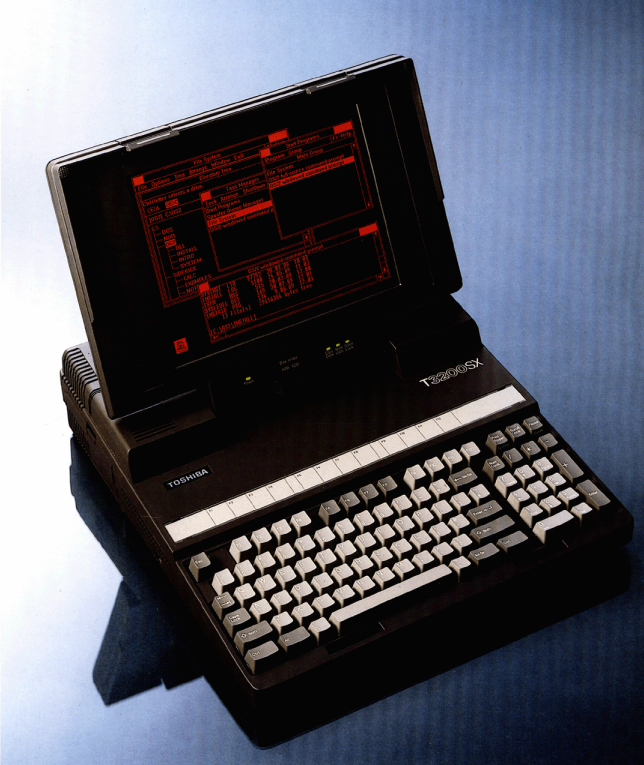 A 386DX-based laptop, the T3200SX was available in both monochrome (T3200SX) and passive colour matrix versions (T3200SXC). Aside from the much nicer colour display, the T3200SXC also got a faster 20 MHz processor over the T3200SX's 16 MHz one. Both weighed around 17 lbs.
A 386DX-based laptop, the T3200SX was available in both monochrome (T3200SX) and passive colour matrix versions (T3200SXC). Aside from the much nicer colour display, the T3200SXC also got a faster 20 MHz processor over the T3200SX's 16 MHz one. Both weighed around 17 lbs.
The T3200SX came with either a 40 MB (Conner CP-3000) or 80 MB IDE hard disk. A T3200SX/120 was also made available that came with a massive 120 MB hard disk (again, a Conner unit CP-30104). The 3200-range was bundled with a choice of operating system from Toshiba MS-DOS 3.3 or 4.01 (optional) to OS/2 1.1 and even T/PIX 2.1 (AT&T Unix System V). Click here for the T3200SX User Manual.
 In March 1990, Toshiba's first 386-based laptop was launched in the form of the T3100SX for $5,999.
In March 1990, Toshiba's first 386-based laptop was launched in the form of the T3100SX for $5,999.
Not only was the 386 a much faster processor than the earlier T3100 series' 80286, but it also came with a VGA-compatible display (though it was still monochrome gas plasma). Its RAM capacity could be upgraded to a maximum of 13 MB via either 2 MB or 4 MB memory modules. The BIOS also supported ROM shadowing for faster BIOS calls.
The 3100SX competed directly with the NEC ProSpeed CSX, which I believe was the very first laptop computer with a colour display.
At the time of the T3100SX's launch, NEC, Sharp and several other laptop computer manufacturers had colour display models out for sale. The more expensive ones used the then-new 'active matrix', also known as 'thin-film transistor' or TFT technology, which had a transistor behind each pixel allowing for complete control over its colour and intensity. You would have had to pay around $2,500 - $3,000 more for a laptop with this technology in 1991.
Cheaper colour displays used passive-matrix technology which produced smearing when things like windows were dragged around the screen, and the colours were not as vivid. Still, if you were on a budget it was a better option than monochrome and would typically cost around $1,000 more. Read my Laptop Displays article for more information on these different types of technology.
"With the T1000LE, Toshiba has refined an already highly-advanced art form. This system shows that Toshiba best understands what people need from a laptop. Any laptop requires compromises. The Toshiba T1000LE's compromises seem to be based on what real people want in a laptop; a truly portable machine that handles most pre-Windows 3.0 applications well." PC Magazine, March 1991
In 1990, if lightweight was your primary driver but you still wanted a 386SX processor, the GRiDCase 1550SX was king of the hill, weighing in at 12 lbs. For those looking for an entry-level laptop but still light on weight, Toshiba still sold the T1000LE - better than the original T1000, it came with both a built-in hard disk and floppy drive, and weighed just 6.5 lbs.
In Part 2, we'll push forward for the period 1991 to 1993.
